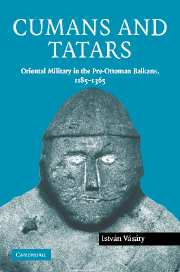Book contents
- Frontmatter
- Contents
- Preface
- 1 Introduction
- 2 Cumans and the Second Bulgarian Empire
- 3 Cumans in the Balkans before the Tatar conquest, 1241
- 4 The first period of Tatar influence in the Balkans, 1242–1282
- 5 The heyday of Tatar influence in the Balkans, 1280–1301
- 6 Cumans and Tatars on the Serbian scene
- 7 Cumans in Byzantine service after the Tatar conquest, 1242–1333
- 8 The Tatars fade away from Bulgaria and Byzantium, 1320–1354
- 9 The emergence of two Romanian principalities in Cumania, 1330, 1364
- Conclusion
- Appendix 1 List of geographical names
- Appendix 2 Chronological table of dynasties
- Appendix 3 Maps
- List of abbreviations
- Bibliography
- Index
Preface
Published online by Cambridge University Press: 29 July 2009
- Frontmatter
- Contents
- Preface
- 1 Introduction
- 2 Cumans and the Second Bulgarian Empire
- 3 Cumans in the Balkans before the Tatar conquest, 1241
- 4 The first period of Tatar influence in the Balkans, 1242–1282
- 5 The heyday of Tatar influence in the Balkans, 1280–1301
- 6 Cumans and Tatars on the Serbian scene
- 7 Cumans in Byzantine service after the Tatar conquest, 1242–1333
- 8 The Tatars fade away from Bulgaria and Byzantium, 1320–1354
- 9 The emergence of two Romanian principalities in Cumania, 1330, 1364
- Conclusion
- Appendix 1 List of geographical names
- Appendix 2 Chronological table of dynasties
- Appendix 3 Maps
- List of abbreviations
- Bibliography
- Index
Summary
From the first moment of its existence until its final fall in 1453, Byzantium had to face the imminent danger of barbaric attacks and incursions. The most frequent and dangerous of these attacks reached the empire from north of the Danube, notwithstanding that the deadly blow to Constantinople was dealt by the Ottomans arriving from the the East through Anatolia. Beginning with the Huns in the second half of the fourth century ad and ending with the Tatars in the thirteenth century, the barbaric hordes had frequently crossed the Danube and ravaged and pillaged the towns of the Balkan Peninsula, leaving them in ruins. More than once they made their incursions close to the Golden Horn, thereby endangering the imperial capital itself. Byzantium had learnt clever ways of handling the nomadic question, the most effective being the hire of nomadic warriors as auxiliaries to fight against Byzantium's enemies. But even the most cunning diplomacy could not prevent the temporary influxes of nomads, which, more often than not, proved devastating to the sedentary population of the Balkans. The nomads were generally compelled to cross the Danube by other nomads from the East, so it was a whole chain of warlike events that led to the appearance of barbaric nomads in Byzantine territory.
One major wave of nomadic tribes proved instrumental in the formation of a new state: Esperükh's nomadic warriors founded the Bulgarian Empire between the Danube and the Haimos (Balkan) Mountains in 679–80.
- Type
- Chapter
- Information
- Cumans and TatarsOriental Military in the Pre-Ottoman Balkans, 1185–1365, pp. xi - xviPublisher: Cambridge University PressPrint publication year: 2005



